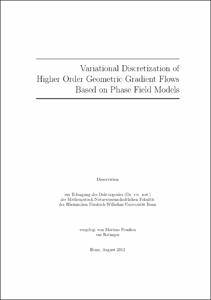Variational Discretization of Higher Order Geometric Gradient Flows Based on Phase Field Models

Variational Discretization of Higher Order Geometric Gradient Flows Based on Phase Field Models

| dc.contributor.advisor | Rumpf, Martin | |
| dc.contributor.author | Franken, Martina | |
| dc.date.accessioned | 2020-04-18T18:02:06Z | |
| dc.date.available | 2020-04-18T18:02:06Z | |
| dc.date.issued | 21.03.2013 | |
| dc.identifier.uri | https://hdl.handle.net/20.500.11811/5642 | |
| dc.description.abstract | In this thesis a phase field based nested variational time discretization for Willmore flow is presented. The basic idea of our model is to approximate the mean curvature by a time-discrete, approximate speed of the mean curvature motion. This speed is computed by a fully implicit time step of mean curvature motion, which forms the inner problem of our model. It is set up as a minimization problem taking into account the concept of natural time discretization. The outer problem is a variational problem balancing between the L2-distance of the surface at two consecutive time steps and the decay of the Willmore energy. This is a typical ansatz in case of natural time discretization as it is used in the inner problem. Within the Willmore energy the mean curvature is approximated as mentioned above. Consequently our model is a nested variational and leads to a PDE constraint optimization problem to compute a single time step. It allows time steps up to the size of the spatial grid width. A corresponding parametric version of this model based on finite elements on a triangulation of the evolving geometry was investigated by Olischläger and Rumpf. In this work we derive the corresponding phase field version and prove the existence of a solution. Since biharmonic heat flow is a linear model problem for our nested time discretization of Willmore flow we transfer our model to the linear case. Moreover we present error estimates for the fully discrete biharmonic heat flow and validate them numerically. In addition we compare our model with the semi-implicit phase field scheme for Willmore flow introduced by Du et al. which leads to the result that our nested variational method is significantly more robust. An application of our nested time discretized Willmore model consists in reconstructing a hypersurface corresponding to a given lower-dimensional apparent contour or Huffman labeling. The apparent contour separates the regions where the number of intersections between the hypersurface and the projection ray is constant and the labeling which specifies these intersection numbers is called Huffman labeling. For reconstructing the hypersurface we minimize a regularization energy consisting of the scaled area and Willmore energy subject to the constraint that the Huffman labeling of the minimizing surface equals the given Huffman labeling almost everywhere. To solve the corresponding phase field problem we use an algorithm alternating the minimizes of the regularization and mismatch energy. Moreover we use a multigrid ansatz. In most parts of this work our nested variational problem is solved by setting up the corresponding Lagrange equation and solving the resulting saddle point problem. An alternative is presented in the last part of this work. It deals with the problem of solving the linear model problem as well as our nested variational problem with an Augmented Lagrange method. | en |
| dc.language.iso | eng | |
| dc.rights | In Copyright | |
| dc.rights.uri | http://rightsstatements.org/vocab/InC/1.0/ | |
| dc.subject | Higher-order parabolic equations | |
| dc.subject | Newton-type methods | |
| dc.subject | Geometric evolution equations | |
| dc.subject | Finite elements | |
| dc.subject | Rayleigh-Ritz and Galerkin methods | |
| dc.subject | finite methods | |
| dc.subject | Optimization and variational techniques | |
| dc.subject.ddc | 510 Mathematik | |
| dc.title | Variational Discretization of Higher Order Geometric Gradient Flows Based on Phase Field Models | |
| dc.type | Dissertation oder Habilitation | |
| dc.publisher.name | Universitäts- und Landesbibliothek Bonn | |
| dc.publisher.location | Bonn | |
| dc.rights.accessRights | openAccess | |
| dc.identifier.urn | https://nbn-resolving.org/urn:nbn:de:hbz:5n-31469 | |
| ulbbn.pubtype | Erstveröffentlichung | |
| ulbbnediss.affiliation.name | Rheinische Friedrich-Wilhelms-Universität Bonn | |
| ulbbnediss.affiliation.location | Bonn | |
| ulbbnediss.thesis.level | Dissertation | |
| ulbbnediss.dissID | 3146 | |
| ulbbnediss.date.accepted | 04.02.2013 | |
| ulbbnediss.fakultaet | Mathematisch-Naturwissenschaftliche Fakultät | |
| dc.contributor.coReferee | Rauhut, Holger |
Files in this item
This item appears in the following Collection(s)
-
E-Dissertationen (4405)




